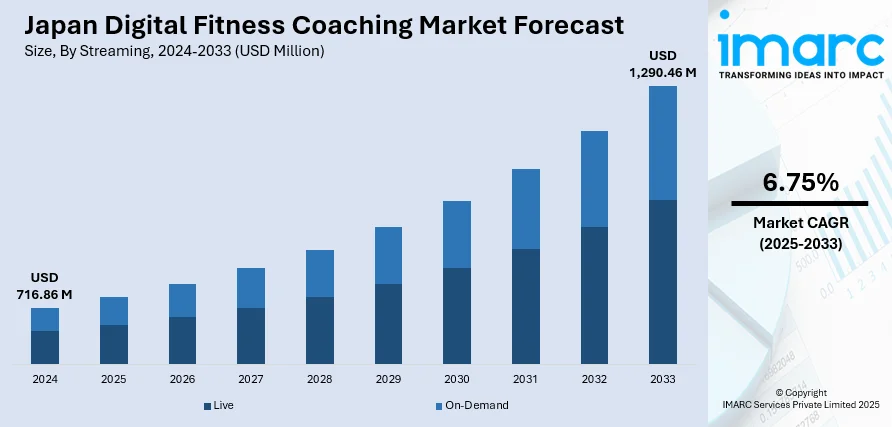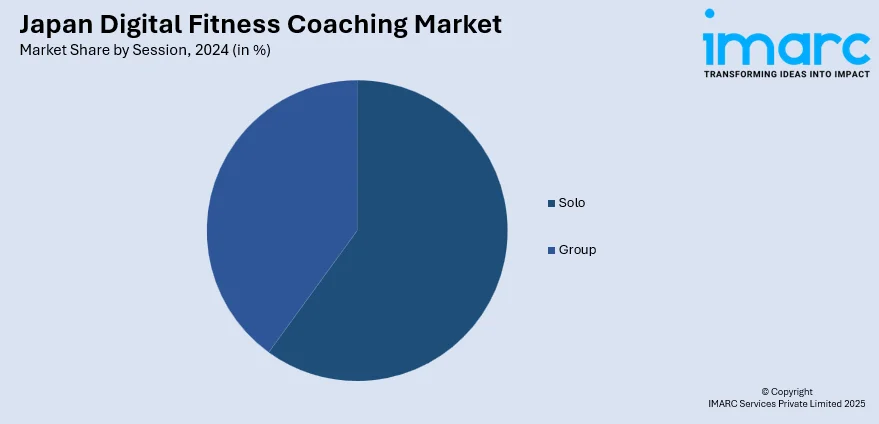
Japan Digital Fitness Coaching Market Size, Share, Trends and Forecast by Streaming, Session, Revenue Model, Device, and Region, 2025-2033
Japan Digital Fitness Coaching Market Overview:
The Japan digital fitness coaching market size reached USD 716.86 Million in 2024. Looking forward, IMARC Group expects the market to reach USD 1,290.46 Million by 2033, exhibiting a growth rate (CAGR) of 6.75% during 2025-2033. The market is witnessing growth due to increasing health consciousness, aging population needs, and the demand for convenient at-home fitness solutions. Technological advancements, including AI-powered apps and wearable integration, are also enhancing user experiences and personalization. These evolving consumer preferences are shaping the competitive landscape of the Japan digital fitness coaching market share.
|
Report Attribute
|
Key Statistics
|
|---|---|
|
Base Year
|
2024 |
|
Forecast Years
|
2025-2033
|
|
Historical Years
|
2019-2024
|
| Market Size in 2024 | USD 716.86 Million |
| Market Forecast in 2033 | USD 1,290.46 Million |
| Market Growth Rate 2025-2033 | 6.75% |
Japan Digital Fitness Coaching Market Trends:
Aging Population and Preventive Health Focus
Japan has one of the world’s most rapidly aging populations, making preventive health and wellness a national priority. Digital fitness coaching platforms offer older adults’ convenient access to low-impact exercise routines, mobility training, and health monitoring features, helping them maintain independence and quality of life. Many of these platforms are tailored to accommodate aging users, with simplified interfaces and specialized programs. The government and private sectors actively promote healthy aging initiatives, which align with the availability of at-home digital fitness solutions. This growing demographic’s demand for accessible, preventive healthcare alternatives is accelerating the adoption of virtual fitness coaching. As healthcare costs rise, digital fitness becomes a cost-effective tool for promoting physical well-being among Japan’s elderly population.

Integration of Advanced Technology and Wearables
Japan’s reputation for technological innovation supports the rapid integration of smart wearables and digital platforms into the fitness industry. Devices like smartwatches and fitness bands collect biometric data, which syncs with coaching apps to offer real-time feedback and tailored fitness plans. Artificial intelligence and machine learning further enhance personalization, allowing platforms to adapt based on user behavior, fitness levels, and goals. Many apps also support VR workouts, voice-guided sessions, and AR-based interactive training, offering immersive and engaging experiences. Japan’s consumer base, already familiar with high-tech solutions in daily life, is well-positioned to adopt these innovations. The continuous evolution of digital health tech is significantly enhancing the quality, convenience, and effectiveness of digital fitness coaching in the Japanese market.
Urban Lifestyle and Time Constraints
Japan’s densely populated urban centers and fast-paced work culture leave little time for traditional gym visits. Digital fitness coaching offers a solution tailored to these time constraints by enabling users to access expert-led workouts, meal plans, and progress tracking at their convenience—at home, in the office, or on the go. The ability to choose workout duration, intensity, and format gives users flexibility to integrate fitness into their busy routines. Additionally, the country’s efficient digital infrastructure and high smartphone penetration facilitate smooth access to fitness apps and online coaching services. For many urban professionals and students, digital fitness provides an accessible, cost-effective alternative to physical gym memberships, making it a key factor in the Japan digital fitness coaching market growth.
Japan Digital Fitness Coaching Market Segmentation:
IMARC Group provides an analysis of the key trends in each segment of the market, along with forecasts at the country and regional levels for 2025-2033. Our report has categorized the market based on streaming, session, revenue model, and device.
Streaming Insights:
- Live
- On-Demand
The report has provided a detailed breakup and analysis of the market based on streaming. This includes live and on-demand.
Session Insights:

- Solo
- Group
A detailed breakup and analysis of the market based on the session have also been provided in the report. This includes solo and group.
Revenue Model Insights:
- Subscription Model
- Pay-Per-Session Model
A detailed breakup and analysis of the market based on the revenue model have also been provided in the report. This includes subscription model and pay-per-session model.
Device Insights:
- Smartphones and Tablets
- Smart TV
- Laptops and Desktops
A detailed breakup and analysis of the market based on the device have also been provided in the report. This includes smartphones and tablets, smart TV, and laptops and desktops.
Regional Insights:
- Kanto Region
- Kansai/Kinki Region
- Central/ Chubu Region
- Kyushu-Okinawa Region
- Tohoku Region
- Chugoku Region
- Hokkaido Region
- Shikoku Region
The report has also provided a comprehensive analysis of all the major regional markets, which include the Kanto Region, Kansai/Kinki Region, Central/ Chubu Region, Kyushu-Okinawa Region, Tohoku Region, Chugoku Region, Hokkaido Region, and Shikoku Region.
Competitive Landscape:
The market research report has also provided a comprehensive analysis of the competitive landscape. Competitive analysis such as market structure, key player positioning, top winning strategies, competitive dashboard, and company evaluation quadrant has been covered in the report. Also, detailed profiles of all major companies have been provided.
Japan Digital Fitness Coaching Market News:
- In January 2024, Xponential Fitness, Inc. announced that Sunpark Co. Ltd., their current Master Franchisee for StretchLab, signed a Master Franchise Agreement with Xponential for Pure Barre and YogaSix in Japan. In Japan, Sunpark has pledged to open at least 50 franchised studios for Pure Barre and Yoga Six. With this partnership, Xponential now has seven brands in Japan, the most outside of North America. Prior deals were made with CycleBar, Club Pilates, AKT, Rumble, and StretchLab.
Japan Digital Fitness Coaching Market Report Coverage:
| Report Features | Details |
|---|---|
| Base Year of the Analysis | 2024 |
| Historical Period | 2019-2024 |
| Forecast Period | 2025-2033 |
| Units | Million USD |
| Scope of the Report | Exploration of Historical Trends and Market Outlook, Industry Catalysts and Challenges, Segment-Wise Historical and Future Market Assessment:
|
| Streamings Covered | Live, On-Demand |
| Sessions Covered | Solo, Group |
| Revenue Models Covered | Subscription Model, Pay-Per-Session Model |
| Devices Covered | Smartphones and Tablets, Smart TV, Laptops and Desktops |
| Regions Covered | Kanto Region, Kansai/Kinki Region, Central/ Chubu Region, Kyushu-Okinawa Region, Tohoku Region, Chugoku Region, Hokkaido Region, Shikoku Region |
| Customization Scope | 10% Free Customization |
| Post-Sale Analyst Support | 10-12 Weeks |
| Delivery Format | PDF and Excel through Email (We can also provide the editable version of the report in PPT/Word format on special request) |
Key Questions Answered in This Report:
- How has the Japan digital fitness coaching market performed so far and how will it perform in the coming years?
- What is the breakup of the Japan digital fitness coaching market on the basis of streaming?
- What is the breakup of the Japan digital fitness coaching market on the basis of session?
- What is the breakup of the Japan digital fitness coaching market on the basis of revenue model?
- What is the breakup of the Japan digital fitness coaching market on the basis of device?
- What is the breakup of the Japan digital fitness coaching market on the basis of region?
- What are the various stages in the value chain of the Japan digital fitness coaching market?
- What are the key driving factors and challenges in the Japan digital fitness coaching market?
- What is the structure of the Japan digital fitness coaching market and who are the key players?
- What is the degree of competition in the Japan digital fitness coaching market?
Key Benefits for Stakeholders:
- IMARC’s industry report offers a comprehensive quantitative analysis of various market segments, historical and current market trends, market forecasts, and dynamics of the Japan digital fitness coaching market from 2019-2033.
- The research report provides the latest information on the market drivers, challenges, and opportunities in the Japan digital fitness coaching market.
- Porter's five forces analysis assist stakeholders in assessing the impact of new entrants, competitive rivalry, supplier power, buyer power, and the threat of substitution. It helps stakeholders to analyze the level of competition within the Japan digital fitness coaching industry and its attractiveness.
- Competitive landscape allows stakeholders to understand their competitive environment and provides an insight into the current positions of key players in the market.
Need more help?
- Speak to our experienced analysts for insights on the current market scenarios.
- Include additional segments and countries to customize the report as per your requirement.
- Gain an unparalleled competitive advantage in your domain by understanding how to utilize the report and positively impacting your operations and revenue.
- For further assistance, please connect with our analysts.
 Request Customization
Request Customization
 Speak to an Analyst
Speak to an Analyst
 Request Brochure
Request Brochure
 Inquire Before Buying
Inquire Before Buying




.webp)




.webp)












